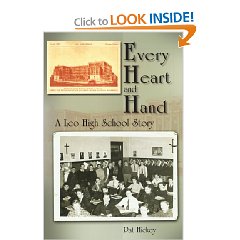Battle Ribbons for PFC Patrick E, Hickey, USMCR -1943-1945 ( Bougainville, Guam and Iwo Jima)

Dad carrying the tripod on Guam* and looking old at 19 years.


" It was rugged." - Personal narrative of WWII by PFC Patrick E, Hickey, USMCR (dec.)
God Bless you, Dad and all who protect us and our Freedoms.
Able Company ( Capt. Geary Bundschu) 1st Batallion, 3rd Marines pinned down during the three attack up the cliffs later named for Capt. Bundschu. At the center of this old photo are what is left of A Company in July 1994 on Guam.
the 1st Battalion landed and started across rice paddies toward Bundschu Ridge, a nose of land running down toward the beach,25 enemy machine guns began to fire from the woods bordering the open ground. Company B, in assault on the right, quickly cleared these woods and made good progress until it ran into jungle and rock.
The Japanese did not give Company A, on the left, time to organize for an assault, but opened fire on LVT's as they moved ashore and stopped to unload troops. Casualties mounted as reorganization got under way. Enemy opposition, plus the fact that terrain bore little resemblance to that studied on maps and models, added to the normal confusion which--43--
follows any assault landing.26 But cool thinking and the training under adverse conditions on Guadalcanal paid off. Captain Geary R. Bundschu quickly organized his company and made preparations for the assault on the ridge that already bore his name. (See Map 13)
The attack started with two platoons in assault and one in support, but the going was slow and rough. The support platoon had to be committed in short order. This added strength enabled Bundschu to get within 100 yards of the top by 1045, but he reported he needed corpsmen and stretchers badly. This message gave just a hint of things to come. Moving that last 100 yards proved to be a lengthy and costly business. Only one officer, Lieutenant James A. Gallo, Jr., and a few men of the company survived the action that followed.
It is doubtful if Captain Bundschu realized until after 1200 what he was up against.27 The initial assault on the ridge had been driven back by two machine guns emplaced to deliver enfilade fire on advancing troops. A platoon tried to flank one position by going up a heavily wooded gully but the waiting Japanese forced it to withdraw. About 1400 Bundschu asked his battalion commander, Major Henry Aplington, II, for permission to disengage. But Aplington felt this could not be done because of the unit being so involved. However, the right platoon (1st) succeeded in disengaging. Lieutenant Gallo, its leader, reorganized the remnants of his unit and those of the 3d Platoon and awaited orders from his company commander.28After a conference between the regimental commander and Captain Bundschu, Colonel Hall ordered a second frontal assault on the ridge. Bundschu and Gallo organized the remaining men of Company A into two forces for the attempt. The company commander requested that an 81mm mortar barrage be placed on the hill,29 and just before sundown the attack started. Bundschu and his men inched forward but the same machine gun that had caused them trouble earlier in the day soon stopped the advance. Repeated attempts to take the position failed. Finally, covered by fire from every available weapon, the Marines silenced the gun with grenades. An assault reached the top of the hill, but by this time the remaining handful of Marines found it impossible to reorganize and defend this crest.30On the right, Lieutenant Gallo and his men fared no better. Under cover of the 81mm barrage, they crawled up the ridge and reached a position under the machine gun in their sector. But the Japanese, by rolling hand grenades down on the advancing troops, made the position untenable and halted the attack. Little had been accomplished. The company was back where it had been earlier in the day, but this time with fewer men.31During the course of the Bundschu Ridge action, the regimental commander had decided to commit his reserve, Lieutenant Colonel Hector de Zayas' 2d Battalion. When it became apparent that the enemy offered the most resistance in the center of the zone of action, Hall alerted de Zayas' unit for a move into the line between the two assault battalions. Shortly thereafter, at 1300, Colonel Hall assembled his battalion commanders on top of Chonito Cliff and issued his fragmentary order:
* from Scott Carmichael's forthcoming book Bundschu Ridge
Despite the rigorous training schedule which left them filthy and exhausted most days, the enlisted men found time and energy to temporarily escape the regimentation of an infantryman’s life through the pursuit of personal interests and hobbies. Pfc’s Patrick E. Hickey of Chicago and Boyd C. Troup of Michigan discovered the game of horseshoe. Hickey was the son of Irish immigrants; he was one of 13 kids in his family, and he was barely 19 years old when he joined the Marine Corps. He and Boyd were machine gunners in 2LT Henry Oliver’s machine gun platoon, and neither of them had ever played the game of horseshoes before their arrival on Guadalcanal. Boyd recalled that each of them threw ‘ringers’ on their very first tosses, and ‘laughed like hell’ because they couldn’t possibly have done that on purpose, had they tried. They were hooked on the game from the beginning, and passed much of their spare time tossing iron shoes at a stake in the ground.

.jpg)





No comments:
Post a Comment